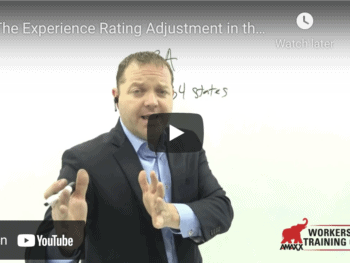
Employers considering large deductible policies need a deep understanding of their own companies and thorough contract vetting before signing up. There are several strategies that employers should undertake before considering a large deductible policy.
Click Link to Access Free PDF Download
“How to Calculate Your Minimum Experience Mod, Controllable Premium & the Revenue Impact”
The Policy
These arrangements include a set deductible amount for each claim. However, those in the workers’ compensation system differ from those in other insurance lines. The typical policy has the client paying a claim up to the deductible amount, at which point the insurer takes over the claims payments. In workers’ compensation, the insurer generally pays the entire claim and reimburses the employer for the agreed-upon deductible amount. In a typical large deductible workers’ compensation policy with a $2 million claim and a $100,000 deductible, the insurer would pay the entire claim and then seek reimbursement of $100,000 from the employer.
The laws and rules covering these policies differ among jurisdictions and are often somewhat vague. For example, there is no standard as to what constitutes a ‘large’ or ‘mega’ deductible amount. Some jurisdictions define large deductibles as $100,000 or more and mega deductibles as at least $750,000. Nevada, however, requires any deductible over $25,000 to be reported to the state. Some companies set the mega deductible amount at $10 million. Mega deductible policies generally involve more underwriting and regulatory oversight than large deductible policies.
When used successfully, employers can see premium reductions, tax savings, increased efforts toward safety to prevent claims, and incentives to care for and get injured workers back to work quickly.
Potential problems
Problems can arise when employers do not understand the risks involved, experience unexpected revenue shortfalls, or overestimate their company’s financial strength, especially in the long term. Because of the long-tail nature of workers’ compensation claims, reimbursement may extend for years. Companies that cannot pay run into trouble.
Often the policies involve ‘side agreements’ that make them even more complicated and, sometimes, misunderstood by the employer. There are a variety of reasons and requirements for these. Some, for example, basically eliminate the operation of experience modification factors. Others may substitute a unified overall rate for the typical classification system. Some include language about the premium charges that effectively contradict the actual policy terms. Some may actually change the policy’s provisions without being endorsed onto the policy, leading to conflicts.
Still, other problems may arise when employers are mistakenly led to believe they are responsible for paying the claims in order to get lower up-front costs and avoid experience modifications for claims within the deductible limits. That may result in errors in claims handling – even unintentionally.
Large deductible policies are not regulated to the extent of self-insurance; however, some employers may use them as such, whether knowingly or unknowingly. Employers that view large deductible policies as self-insurance may mistakenly believe they should or can manage their companies’ claims. They run the risk of violating state laws regarding such things as the choice of the healthcare provider or retaliation for making a claim. That can lead to delayed care, more harm to the injured worker, disputes with the insurer, claims handling abuses, civil penalties, and ultimately significantly higher costs.
In one case, for example, a small company contracted with a professional employer organization for its human resource services. The PEO purchased a workers’ compensation policy with a $1 million deductible, lowering its premium and the costs billed to the company. The problem arose when a worker filed a claim and, despite assurances that all was fine, the PEO went out of business, and the insurer was declared insolvent. The company turned to the Minnesota guarantee fund for payment. However, due to statute language, the company was ultimately found liable for the $1 million deductible.
FREE DOWNLOAD: “How to Calculate Your Minimum Experience Mod, Controllable Premium & the Revenue Impact”
Additional problems can occur if employers fail to accurately report all claims in a timely manner. Delayed reporting may leave the insurer under reserved, leading to its insolvency. Failing to report claims may result in enforcement by a state regulatory agency, leading to civil penalties for each violation.
What to do
Employers either considering or just starting to use a large deductible policy have a much better chance of reaping the benefits by following a few simple steps.
- Read the fine print. Make sure you truly understand your obligations and those of the insurer.
- Check side agreements. Understand all details about any side agreement.
- Know your financials. Make sure your company has the financial ability to reimburse the insurer when payment is due. Past claims history and your company’s overall financial strength should be scrutinized before considering a large deductible policy.
- Report injuries. Report them accurately and timely. Delayed, under-reporting and non-reporting injuries can cause the insurer and employer myriad problems. As mentioned above, the potential for under-reserving by the insurer could have grave consequences. Noncompliance with state reporting requirements can lead to fines against the employer and insurer.
- Don’t circumvent policy language. If the policy calls for the insurer to pay the losses, as most of these do, adhere to it. Not doing so can lead to claims handling abuses and extra costs.
Conclusion
Large, well-capitalized employers may be prime candidates for large or mega deductible policies, which can substantially reduce costs. However, it’s essential to ensure your company has the financial ability and wherewithal to strictly adhere to such a policy to see the benefits.

Contact: mstack@reduceyourworkerscomp.com.
Workers’ Comp Roundup Blog: http://blog.reduceyourworkerscomp.com/
©2023 Amaxx LLC. All rights reserved under International Copyright Law.
Do not use this information without independent verification. All state laws vary. You should consult with your insurance broker, attorney, or qualified professional.















 20 Common Adjuster Mistakes And What To Do About It
20 Common Adjuster Mistakes And What To Do About It
